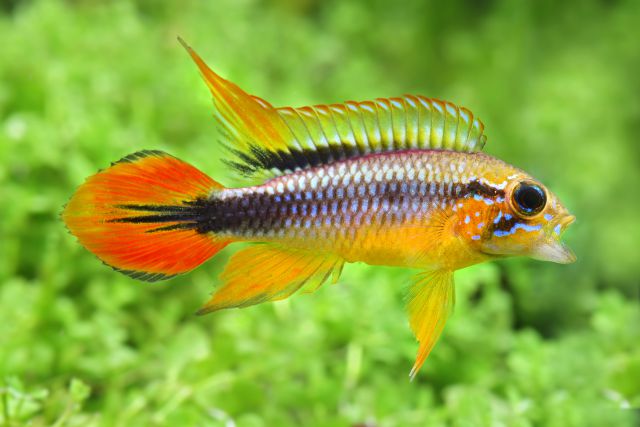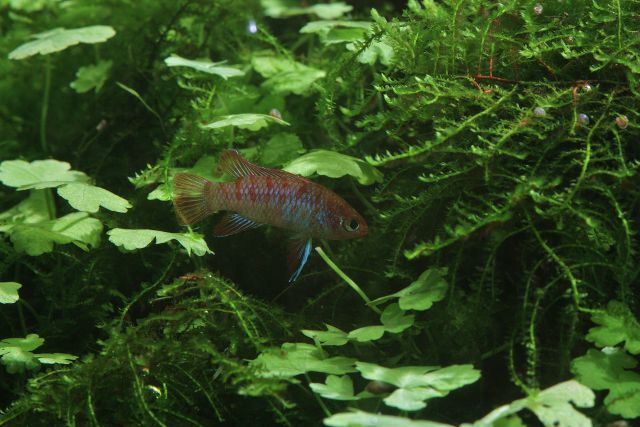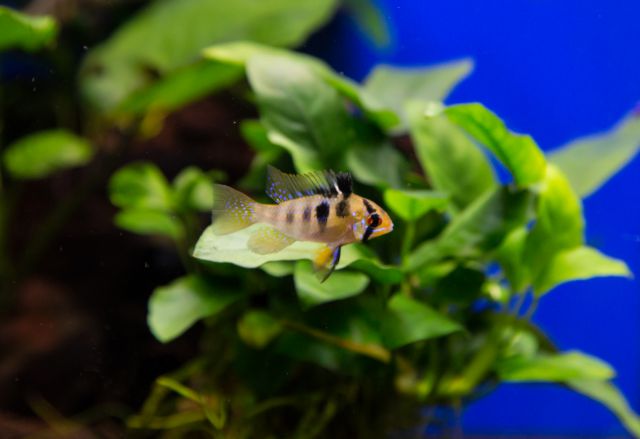The cichlids (Cichlidae) are a fish family very rich in species, containing about 1700 of them. Cichlids are very popular in the aquarium hobby. In addition to angelfish and discus, the African cichlids from the lakes Malawi and Tanganyika also form part of this taxonomic family. The large cichlids from Africa are not really suitable for a planted aquarium, though. Plants are sparse in their natural habitats, and in the aquarium the fish basically consider them food. Only hard-leaved aquarium plants such as Anubias stand a chance of surviving. For an overview of cichlid-proof aquatic plants, please click here. What is even more important: The preferred water parameters of African cichlids (high temperatures, hard and alkaline water) do not match those of most tropical aquatic plants. In addition, some larger species - especially during mating season - treat the decoration and the aquarium substrate rather roughly. When these fish build their nests, things inside the aquarium get spectacular - but that's also exactly the reason why big cichlids are better off in a biotope aquarium than in a laboriously - and lovingly - designed aquascape.
In the following, we will present some smaller cichlids better suited for a planted aquarium.
Dwarf cichlids for planted aquaria
For an aquarium with the focus on aquatic plants or aquascaping, cichlid species whose preferred water values coincide with those of the most common aquarium plant species are suitable. Usually the water has a slightly acidic pH value below 7, and is soft with a low hardness and a slightly warmer temperature range of 22 to 27 ° Celsius. Dwarf cichlids are definitely an option for such a tank. Since most (male) cichlids are territorial, the aquarium should be well-structured with decoration and plants in order to offer the fish places to hide and to spawn.
Apistogramma species

Copyright by Chris Lukhaup.
Many extremely colorful dwarf cichlid species from South America belong in the genus Apistogramma, like for example the very popular cockatoo dwarf cichlid (Apistogramma cacatuoides). These small to medium-sized fish, measuring less than 10 cm in length, are well-suited for a planted aquarium, as aquatic plants also occur in their natural habitats. The sexes are well differentiated, with the male fish usually being larger and more colorful with longer fins. Apistogramma dwarf cichlids are substrate spawners and need hiding places or caves in the aquarium. Structure can certainly also be created with suitable plants and decoration consisting of stones or driftwood.
For some Apistogramma species the aquarium should have a sandy bottom, at least in some areas, because the fish chew sand in order to find food. In addition to that, live and frozen foods are particularly suitable. Since these cichlids are distinctively territorial and as even the females defend their territories during the breeding season, the aquarium should be sufficiently large. In the wild, a male specimen lives in a harem with several females. Due to the spatial conditions in the aquarium, however, keeping them in pairs is more recommendable.
Dario

Especially in recent years, colorful small-scale cichlids such as Dario dario from India have become more and more popular. The small scarlet badis grows to a maximum length of 3 cm and can therefore even be kept in a nano tank.
In contrast to the typical cichlids from South America, Dario dario prefers slightly cooler temperatures of just over 20 °C. While the females are simply gray, the males have a striking red and blue pattern. Feeding them is somewhat difficult because these fish almost exclusively accept live food that needs to be small enough for their tiny mouths. Freshly hatched brine shrimp nauplii and micro-worms are ideal for them. If Dario dario is kept in an aquarium with dwarf shrimp, the cichlids won't say no to eating their tiny offspring for sure. Please take that into account when choosing the stock for your aquarium. Socialization with other, non-territorial fish does not pose a problem.
Mikrogeophagus

The South American butterfly cichlids, which attract attention with their beautiful colors and patterns, have been around in the aquarium hobby for quite a while now. These fish remain relatively small with a total length of about 6 cm. Females can be recognized by their reddish breast part, furthermore their second dorsal fin ray is shorter than that of the males. These fish live in pairs and are so-called open breeders. This means that spawning takes place on flat stones, leaves or in shallow craters in the soil, which the fish dig before taking up their mating ritual. Both male and female care for the brood afterwards, therefore the appropriate aquarium decoration should be chosen. As with most dwarf cichlids, their diet should mainly consist of live or frozen food.
Header Foto: Copyright by Chris Lukhaup.